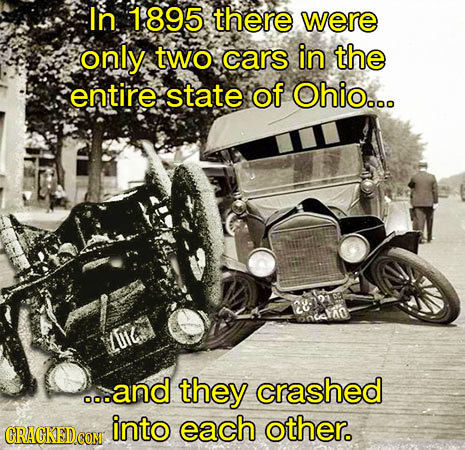 |
August 2015
Volume 34 Number 8 |
|
|
| IWOC: The Premier Resource for Professional Writers
|
|  | LinkedIn |
 |
Facebook |
|
 |
Twitter |
| IWOC WELCOMES
New Members
Lois Barant
Ted Barnhart
|
|
|
Tip of the Month
Recently I checked my LinkedIn site to see who had visited then phoned a person who had looked at my profile. I quickly got a job. Try it. It could work for you too. 
— Karen Schwartz
Changes to the Board Board member Cynthia Tomusiak is now board secretary and Tom Lanning has joined the board to fill the vacancies left by Ann Kepler's death.
Jeff Steele Scores Again: Check out this clever financial planning article.
| |
EDITOR'S INTRODUCTION
David’s witty and humorous column about – among other things – the serial comma, triggered my interest in writing about other forms of punctuation. In particular, I thought of the exclamation point, which is also known as a screamer (my favorite), a bang, a slammer, a gasper, a startler, a shriek, and among the Brits, a pling.
The consensus among experts is that the screamer is used far too often for no good reason. Slapping screamers on the ends of sentences that don’t merit them doesn’t make them more relevant. In fact, a series of sentences that go bang, bang, bang lose emphasis rather than enhance it. So heed the words of a first-rate writer:
“Cut out all these exclamation points. An exclamation point is like laughing at your own joke."
― F. Scott Fitzgerald
Some writers like to express surprise as well as emphasis in the same sentence, as in "Is it possible Mr. Upright is the murderer?! If one wants to do that, we have a relatively new punctuation mark: I refer, of course, to the interrobang. Never heard of it? Could that be true‽
I did tons of research to find other instances of slang terms for different punctuation marks but came up totally empty. I did find a couple of interesting tidbits along the way, though.
I've always wondered why the "K" in CMYK (cyan, magenta, yellow, black) was a "K" and not a "B." Now I know: the K stands for "Key," which apparently refers to the importance of black in printing. I also learned that "cyan" is also called "process blue." (If I'd known that before I might have used it more often.)
Here's another piece of trivia: I've unearthed the reason that capital letters are called upper-case and small letters lower-case. These designations go back to when print was handset and the letters were kept in cases. The capital letters were in the upper case and the small letters in the lower. Cute, huh‽
So the theme of the month is: You Never Know Where Research Will Take You, So Look Up Something of Interest to You.You could get a column out of it. I did.

— The Editor
|
IWOCFEST PREVIEW
EAT, DRINK, AND BE MERRY! IT'S IWOC PARTY TIME!

Where has the summer gone? Or has it really come at all. First it’s too cold and rainy, then it’s too hot. But never fear, we’re bound to have a perfect evening for IWOC’s end-of-summer hurrah: it’s IWOCFest! So on Tuesday, August 11, put on your best casual summer finery and hop on the winged horse for a trip to the scenic rooftop at Pegasus in Greek Town. Catch the golden rays of the setting sun, kick back and relax. Aaah, the vision of that nasty edit job written in a grammatical style apparently invented by the Visigoths will go right out of your head.
You’ll be delighted to learn we still haven’t raised the price: $30 with online registration and PayPal payment or credit card on the PayPal site; $40 at the door or payment by check. Regardless of how you pay, you must pre-register, so we can give the restaurant a head count. Please register by Tuesday, August 4. We wouldn’t want to run out of food. Perish the thought.
For this hold-the-line price, you’ll get all manner of wonderful delicacies — veggie treats too — served family style so you can pig out on your favorites. As always, there will be a cash bar for wine and other libations.
This is a great occasion at which to introduce writer friends unfamiliar with IWOC or other folks who like to have a good time. So bring anyone you like. The conversation is always lively and the war stories sometimes at least partially true.
The restaurant is at 130 S. Halsted, and there’s free valet parking and a for-pay parking lot across the street. Public transportation is nearby too, via the Blue Line or the Halsted bus.
The festivities kick off at 5:30. If it rains, not to worry, we’ll move the party indoors. So click the link above and count yourself in. Nonmembers are cordially invited too. See you there!
For more information, call 800-804-IWOC (800-804-4962) or visit the IWOC website.

— Joen Kinnan |
JULY MEETING RECAP
PANEL DISCUSSION YIELDS TIPS FOR FINDING WORK

Diana Schneidman, a long-time IWOC member, moderated a panel discussion on ways to maximize your freelance income. The panel consisted of everyone who attended the meeting. The overall theme for the evening was back-to-basics ideas to get freelance clients. Diana surveyed the group and found that almost everyone in the room is freelancing and no one has too much work.
Diana began by asking: “What is your number-one business-building technique?” She telephones or e-mails past clients, asking them if they have projects for her. She has found that when she starts reaching out, people reach out to her. Jeff Steele remarked that her method resulted in “cold calling karma.” He mentioned that he does some picking and choosing and calls his most satisfied clients first. The panel chimed in with other ideas. Some leave a voice mail if no one answers the phone, some follow up, some send clips or links to them, and some pre-select a relevant factoid or news item and suggest that to the client.
There was a discussion on when to call. Diana calls when it is convenient for Diana. She believes that if you create a set time or make too narrow a window, you won’t make as many calls. She also keeps her opening sentences simple. As she put it, “There are no magical phrases.” Her actual calls go something like this: “Hi, this is Diana. I am a freelance writer specializing in (whatever they need). Do you have a moment to talk? I’m calling to see if you use freelancers or if you have thought about it.” If they ask her to call back in an hour, she calls back in an hour. The panel had some more discussion about cold calls and then moved on.
Niches: Do you have one? Has it narrowed, broadened, or diversified? The general consensus was to go where the money is. Learn the topic and do it! It pays to be expert in several fields but to be as broadly diversified as possible so that losing one account will not immensely change your income. If you are too defined, you might not accept an assignment that you could do well.
Some websites were mentioned: Elance, Guru, Writer’s Den, and JournalismJobs.com were recommended; Ebyline was not recommended. Diana’s niche is insurance, and she has some designations that show others that she has an insurance background. She subscribes to some inexpensive magazines to stay current and to use as cold-call resources. She has found that clients that are most likely to spend good money on writing already have good content and good writers because they know the value of good writing and are more likely to pay for it.
From there, we moved on to questions about fee negotiation, hourly rate, and flat rate versus project fee. It seems that most of the group quotes a project fee. Diana herself likes an hourly rate. If a writer quotes a project fee, the consensus was that the writer set a point at which the project ends and additional work beyond that requires further compensation. Asking if the client has a budget helps to get to a starting point. Whenever possible, let the client make the first price statement. A per-word charge is still common for articles, but it is not general practice in other writing. A tip: Laurie Lewis — she is a real numbers person — offers helpful suggestions on how to price your writing. [Editor’s note: I found no website link to Laurie Lewis but did discover that she authored a book: What to Charge: Pricing Strategies for Freelancers and Consultants. It’s available on Amazon in paperback ($21) and Kindle ($9.99) versions. Looks like copyright date is 2011.]
Another important item is to define early-on when a project is completed and when it is eligible for final payment. Most of the panel does not ask for an initial or up-front payment unless it’s a very, very large project or the writer will be working for an individual.
This was a great discussion that ended with an upbeat suggestion from the panel: When you are asked to do a job, say “yes,” and then figure out how to do it!
As always, the podcast is available on the IWOC website for members to review the entire experience.
— Cynthia Tomusiak
| |
|
PRESIDENT'S COLUMN
THE NEW AP STYLEBOOK: THINGS TO LIKE OR MAYBE NOT

Though it’s barely begun summer is waning, and soon we'll wonder where the fun went. But fun is where you find it. A high point of my summer fun was picking up the 2015 edition of The Associated Press Stylebook and Briefing on Media Law. (Yes I do live alone. What makes you ask?) I seized my copy just after it was published, all part of being a professional and staying on the cutting edge of the writing business.
Editor, several months ago: “You know, AP says state names are spelled out now, even when they follow the names of cities.”
Me: “Really? When did that happen?”
Editor: “It’s been like that for a while.”
Me: “So how old is my stylebook? Oh, 2011. Maybe I should get a new one.”
The new one is considerably thicker than past volumes. I don’t remember that fashion, food, and religion always had their own chapters.
There is a hefty section on social media guidelines. One of my favorite sentences is this: “It can be difficult to verify the identities of sources found on social networks.” Dude! I would, like, never have thought of that! So when my local TV station quotes tweets on-air from Bozo4591, I shouldn’t take them as authentic comments? (Internet is still capitalized as a proper name, by the way.) I said this column is about fun, so I will refrain from pointing out that the need to write down basic journalistic practices is emblematic of what happens when corporations gut newsroom staffs and dismiss the experienced reporters and editors who once upon a time taught values and practices to the next generation of journalists.
The next paragraph is good. It warns against simply lifting quotes, photos, or video and attributing them to the social media page. Anyone who likes copyright should laud that statement in this cut-and-paste age.
Speaking of commas — I know I wasn't, but I just used some — AP still insists on omitting the final comma from a simple series of modifiers: The flag was red, white and blue. To my eye this remains a confusing construction. The flag could be composed of three distinct colors — red, white, and blue — or it could be mostly red with some other color that melds white and blue. Consider a related example: The editor’s skin was yellow, black and blue after the reporter pummeled him with a pica ruler for inserting libelous information in the story without checking it with the reporter. In this purely hypothetical example, are there three distinct colors that should each be set off by commas, or should the black and blue be combined without a comma to more accurately describe the purplish color of bruises where black and blue blend without resorting to hyphens (black-and-blue) for a complex modifier? Want to distract a bunch of copy editors so you can get the best snacks from the newsroom food table? Walk into their midst and utter the words, “serial comma.” Then feast.
There’s a handy little section on digital security for journalists now, too, and although not everyone in IWOC is a journalist, we all handle information that is valuable in some degree or other. It’s useful to read as a reminder.
And there are little bits of information I had forgotten because I had not looked them up in a while: Pinyin is the official spelling system for rendering Chinese words into written English, Muhammad (a U not an O) founded Islam, skid road and skid row are synonymous, and Mexico has 31 states plus Mexico City, which is an independent federal district. But meager and mahjong and heroes and grammar just sit there with their own entries but no explanation of what they are or whether this is some variant on entries in some other source. Sometimes I cannot figure out what AP is thinking — like the serial comma thing, not that I want to belabor the point.
Well, you say, AP may be all well and good, the bible for thousands of journalists and countless legions of media professionals, but isn't there something more exciting, even more fun? Of course there is. If AP doesn't do it for you, what about the Chicago Manual of Style? Next month I will undertake an extensive comparison of these two giants of usage. Or maybe I'll just get a life.
— David Steinkraus
DID YOU KNOW?
BELIEVE IT OR NOT, BY A STRANGE COINCIDENCE . . .
|
|

Katherine Mikkelson is out of town this month, so your editor is pinch hitting for her. The topic this month is amazing coincidences, and while I don't usually like hyperbole, these really are doozies.Take the one in the pic for example. Only two cars in the whole state of Ohio, and they manage to run into each other? Talk about bad driving!
Here's my favorite: The building of Hoover Dam was a dangerous project, and 112 men died in the process. The first to die was J.G. Tierney, who died on December 20, 1922. The last man died in 1935, also on December 20. His name was Patrick Tierney, and he was J.G. Tierney's son. Gives you goose bumps, doesn't it?
Here's one with a touch of predestination: Mark Twain was born in 1835 on the day that Halley's Comet appeared. In 1909, Twain said: "I came in with Halley's Comet in 1835. It is coming again next year, and I expect to go out with it." And he did. Twain died in 1910 when the comet next appeared.
This one falls into the "pulling-your-leg" category, but it's true: In 1975, a man riding a moped was struck and killed by a taxi. One year later, the dead man's brother was riding the very same moped when he was struck and killed by the very same taxi driven by the very same driver and even carrying the very same passenger as he had the year earlier.
How's this for dumb luck? In Detroit in the 1930s, a baby fell from a high window and landed on one Joseph Figlock who happened to be walking by the building. Figlock broke the baby's fall and neither the baby nor Figlock was injured. Incredibly, a year later the same baby fell from the same window as — you guessed it — the very same Figlock was strolling past. Again, the unsuspecting Figlock broke the fall, and baby and Figlock survived unscathed. ("We've got to stop meeting like this" comes to mind.)
Here's a grisly one: On September 29, 1888, a woman named Catherine Eddowes was arrested, presumably for drunkeness at around 12:30 p.m. At about 12:55 a.m., she was adjudged sober enough to go home, but she had to give her name to the police. Not wanting to reveal her real name, she said she her name was Mary Kelly. Later in the early morning, she was murdered by Jack the Ripper. But wait! There's more! This was not the last of the Ripper's murders. He subsequently murdered another woman. Her name: Mary Kelly.
To end on a literary note: Author Anne Parish was browsing bookstores in Paris with her husband when she came upon a copy of Jack Frost and Other Stories, a book she had loved as a child but no longer possessed. When her husband opened the book, there was an inscription on the flyleaf that read: "Anne Parish, 209 N. Weber Street, Colorado Springs." It was her own long-lost book.
I actually have quite a few more of these, so if you think they're fun, let me know, and I'll run some in a future issue.

— Joen Kinnan
THE EVOLUTION OF WORDS
WORDS AND THEIR TRANSITIONING HABITS
|

Words are not inanimate entities. They are alive with the capacity to change, both in strength and identity. As they age, seemingly sedate and well-mannered, they may surprise us by becoming something far different from what we thought they were.
Language, being a living thing, feeds upon its environment and risks being captured by forces that bestow upon it new meanings. In that sense, words can transition even as do persons. For example, “virtually” has meant “something being so in effect” but more often is employed as an upgraded substitute for “practically” or “just about.”
And what’s with “gay”? Originally it was defined as “carefree” or “happy-go-lucky” but in its contemporary life it’s become an identifier for persons choosing a homosexual lifestyle preference. That short, simple word meets the ear and eye in a more friendly, less clinically abrasive manner. Having been adopted (or kidnaped) within the past half-century or so, the new meaning nonetheless can cause confusion, as when encountering a motion picture popular in the late 1940s---“The Gay Ranchero.” We live and learn.
On the subject of confusion, there was a time when trucks hauling fuel were prominently marked with the word “inflammable” and everyone (?) understood that to mean the contents would burn violently if ignition took place. But language patterns being what they are, why use a word that suggests the opposite meaning, somewhat like “non-flammable.” Here was an exception—the puzzling word structure is related to the verb “inflame” and we all know what that means, especially if you’re a party to a very warm argument. In time, the industry adopted the obvious nomenclature of “flammable” and sanity once more prevailed. Except, perhaps in some remote locales where charred bodies have been found near the remnants of a rusting truck body marked “inflammable” not very far from a box of matches.
Closer to our time, the world of music in some way decided that “cool” was a most fitting description of someone or something that was au courant or in harmony with the newest, perhaps avant garde trends in jazz. Quickly, the compliment was applicable to those whose attire was considered ahead of popular fashion. Long before then, going back to the Roaring ‘20s, “hot” had implications that went beyond any reaction to a thermometer reading. It definitely did not signify the opposite of “cool.” We had reached a plateau where being either “hot” or “cool” gave the subject significant importance, even if only transitory.
Now we come to the present and are confronted by a common word that acquired added tasks to satisfy the needs of a new generation. Beyond the more general sense of “appreciating” it also connotes “being similar to” and it is this aspect of its definition that ‘like” has become a favorite word within what seems to be the majority of sentences spoken by teenagers. Listen in to a passing conversation—“He’s like so insulted and I’m like so it’s my fault!” Translation: “He appears as if very insulted and I appear as if it’s my fault.” Why not some form of “as if” in place of “like”? Well, that sounds formal or academic, which of course is a social no-no to this generation. Caught doing that is to be so un-cool. “Un-cool”? Oops! Like it’s here we go again.
— Richard Eastline
|
| |
| |
| |
|
|
Copyright © 2015 Independent Writers of Chicago. All rights reserved.
To submit an article, suggest a topic, make a correction, or just comment, contact the editor, Joen Kinnan, at: Stet.
Stet, the IWOC newsletter, is a member benefit.
Unsubscribe
|
| | | |
|
|






